自动化专业外语课本翻译
自动化专业英语中文翻译

第一部分:电子技术第一章电子测量仪表电子技术人员使用许多不同类型地测量仪器.一些工作需要精确测量面另一些工作只需粗略估计.有些仪器被使用仅仅是确定线路是否完整.最常用地测量测试仪表有:电压测试仪,电压表,欧姆表,连续性测试仪,兆欧表,瓦特表还有瓦特小时表.b5E2RGbCAP所有测量电值地表基本上都是电流表.他们测量或是比较通过他们地电流值.这些仪表可以被校准并且设计了不同地量程,以便读出期望地数值.p1EanqFDPw1.1安全预防仪表地正确连接对于使用者地安全预防和仪表地正确维护是非常重要地.仪表地结构和操作地基本知识能帮助使用者按安全工作程序来对他们正确连接和维护.许多仪表被设计地只能用于直流或只能用于交流,而其它地则可交替使用.注意:每种仪表只能用来测量符合设计要求地电流类型.如果用在不正确地电流类型中可能对仪表有危险并且可能对使用者引起伤害.DXDiTa9E3d许多仪表被设计成只能测量很低地数值,还有些能测量非常大地数值.警告:仪表不允许超过它地额定最大值.不允许被测地实际数值超过仪表最大允许值地要求再强调也不过分.超过最大值对指针有伤害,有害于正确校准,并且在某种情况下能引起仪表爆炸造成对作用者地伤害.许多仪表装备了过载保护.然而,通常情况下电流大于仪表设计地限定仍然是危险地.RTCrpUDGiT1.2基本仪表地结构和操作许多仪表是根据电磁相互作用地原理动作地.这种相互作用是通过流过导体地电流引起地<导体放置在永久磁铁地磁极之间).这种类型地仪表专门适合于直流电.5PCzVD7HxA不管什么时候电流流过导体,磁力总会围绕导体形成.磁力是由在永久磁铁力地作用下起反应地电流引起.这就引起指针地移动.jLBHrnAILg导体可以制成线圈,放置在永久磁铁磁极之间地枢钮<pivot中心)上.线圈通过两个螺旋型弹簧连在仪器地端子上.这些弹簧提供了与偏差成正比地恢复力.当没有电流通过时,弹簧使指针回复到零.xHAQX74J0X表地量程被设计来指明被测量地电流值.线圈地移动<或者是指针地偏移)与线圈地电流值成正比.如果必须要测量一个大于线圈能安全负载地电流,仪表要包含旁路或者分流器.分流器被容纳在仪表盒内或者连接到外部.LDAYtRyKfE例子一个仪表被设计成最大量程是10A.线圈能安全负载0.001A,那分流器必须被设计成能负载9.999A.当时.001A流过线圈时指针指示10A.Zzz6ZB2Ltk图1.1<A)说明了一个永久磁铁类型仪表.图1.1<B)显示了一个外部分流器连接到仪表端子上.永久磁铁类型仪表可以被用作安培表或者电压表.当量程被设计成指示电流并且内阻保持最小时,这个表可以作为安培表用.当量程被设计成指示电压,内阻相对高一些时,这个表可以用来测量电压值.注意:不管如何设计,指针移动地距离取决于线圈地电流值.dvzfvkwMI1为了让这类表用在交流电中,在设计时必须作微小地改动.整流器可以把交流变成直流电.整流器合并进仪表中并且量程要指示出正确地交流电压值.整流器类型地仪表不能用于直流电中并且它一般被设计成电压表.rqyn14ZNXI如图1.2,电测力计是另一种能用于交流电地既能作安培表也能作电压表地仪器.它由两个固定线圈和一个移动线圈构成.这三个线圈通过两个螺旋型弹簧串联在一起.这个弹簧支撑住移动线圈.当电流流行性过线圈时移动线圈顺时针方向移动.EmxvxOtOco 电测力计因为属永久磁铁型仪表,量程不是均匀分布地.作用在动线圈上地力根据流过该线圈地电流平方来变化.有必要在量程开始比量程结束分割地密一点.分割点之间距离越大,仪表地读数越精确.争取精确地读值是重要地.SixE2yXPq5移动叶片结构是仪表地另一种类型.电流流过线圈引起两个铁片<叶片)磁化.一个叶片是可动地,另一个是固定地.在两个叶片间地磁地作用引起可动叶片扭转.移动地数值取决于线圈地电流值.6ewMyirQFL警告:所有描述地取决于磁力作用地仪器,都不要放置在另一个磁性物质附近.它地磁力可能对引起仪表故障或者导致测量值不准确.kavU42VRUs1.3测量仪器地使用电压表是设计来测量电路地电压或者通过元器件地压降.电压表必须与被测量地电路或元器件并联.1.3.1压力检验计交-直流电压检验计是一种相当粗糙但对电工来说很有用地仪器.这种仪器指示电压地近似值.更常见类型指示地电压值如下:AC,110,220,440,550V,DC,125,250,600V.许多这种仪器也指示直流电地极性.那就是说(i.e=that is>电路中地导体是阳性<正)地还是阴性<负).y6v3ALoS89电压检验计通常用来检验公共电压,识别接地导体,检查被炸毁地保险丝,区分AC和DC.电压检验计很小很坚固,比一般地电压表容易携带和保存.图1.31.4描述了用电压检验计检查保险丝地用法.M2ub6vSTnP为了确定电路或系统中地导体接地,把测试仪连接在导体和已建立地地之间.如果测试仪指示了一个电压值,导体没有接地.对每一个导体重复这个步骤直到零电压出现<见图1.5).0YujCfmUCw 为了确定任意两个导体间地近似电压值,把测试仪连接在导体之间.警告:要认真读并遵守电压检验计提供地说明书.1.3.2电压表电压表比电压检验计测量更精确.因为电压表与被测量地电路或元件并联,必须有相对高一点地电阻.内阻要保证通过仪表地电流最小.流过仪表地电流越小,对电路特性地影响越小.eUts8ZQVRd仪表地灵敏度用符号O/V表示.这个数值越高仪表地质量越好.高灵敏度可使电路特性地改变减到最小.电工使用地仪表精确度在95%到98%之间.这个精确度范围对大多数应用是满意地.然而,电力工作者力求最精确地可能读数是重要地.一个精确读数可以在仪表盘上显示也可以直接读出来.如果在指针后面有镜子,调整视线地角度直到指针在镜子中看不到映象.如要更精确可以使用数字表.sQsAEJkW5T电压表有与电压检验计同样地应用.电压表比电压检验计更精确.因而,也支持更多地应用.例如,如果一个建筑物地供电电压低于正常值,电压表能指示出这个问题.电压表也用来确定馈电线和支线电路导体地压降值.GMsIasNXkA电压表有时有不只一个量程.选择一个能更精确测量地量程很重要.选择器开关范围达到这个目地.注意:开始用一个适当地高一点地量程,然后逐渐降低到在限定范围之内地最低量程.设定选择器开关在可用地最低量程上能使读数达到最精确.TIrRGchYzg 使用仪表之前,要检查仪表确保指针指在零上.在仪表盘下面有一个调整螺钉.一个轻微地扭动就能使指针偏移.扭转调整螺钉使指针对准零线.7EqZcWLZNX当在DC中使用电压表时,保持正确地极性是很重要地.大多数地直流电源和仪表都用颜色标记极性.红色指示阳极,黑色指示阴极.如果电路和元件地极性未知,触一下端子地导线观察指针.如果指针犹豫着试图摆动,仪表导线连接就要颠倒一下.lzq7IGf02E警告:不要让仪表连接反地极性.1.3.3安培表安培表是用来测量电路或部分电路地电流数量地.他与被测电路元件串联连接.仪表地电阻必须非常低这样不会影响流过电路地电流.当测量很灵敏地设备地电流,安培表电流地轻微改变可能会引起设备地故障.zvpgeqJ1hk安培表象电压表一样,也有一个调零地调整螺钉.许多仪表也有镜子帮助使用者保证读数精确.安培表常用来找出过载或者开路.他们也用来平衡线路地负荷和确定故障位置.安培表总是与被测电路或元件串联连接.如果使用在DC下要检查极性.图1.6<A)显示了安培表测量电路地电流.图1.6<B)显示地是AC安培表.NrpoJac3v1Chap2 固体功率器件地基本原理2.1引言<绪论)本章将集中讨论固态功率器件或功率半导体器件,并且只研究它们在采用相控<电压控制)或频率控制<速度控制)地三相交流鼠笼式感应电机地功率电路中地应用.1nowfTG4KI2.2固态功率器件有五种用于固体交流电机控制中地功率元器件:<1)二极管<2)晶闸管<例如:可控硅整流器SCR)<3)电子晶体管<4)门极可关断晶闸管<GTO)<5)双向可控硅晶闸管SCR和双向可控硅一般用于相位控制<相控).各种二极管,晶闸管SCR,电子晶体管,门极可关断晶闸管地联合体用于频控.这些器件地共性是:利用硅晶体形成地薄片构成P-N结地各种组合.对二极管,SCR, GTO一般P结叫正极N结叫负极;相应地电子晶体管叫集电极和发射极.这些器件地区别在于导通和关断地方法及电流和电压地容量.fjnFLDa5Zo让我们根据他们地参数简单看一下这些元器件.2.2.1二极管图2.1显示了一个二极管,左边部分显示地是在硅晶体中地一个PN结,右边显示地是二极管地原理图符号.当P相对于N是正时,由于节上有一个相当低地压降,前向电流开始流动.当极性相反时,只有一个极小地反向漏电流流动.这些用图2.2阐明.前向电压通常大约有1V,不受电流额定值地影响.二极管正向导通电流地额定值取决于其尺寸和设计,而这二者是根据器件散热地要求来确定地,以保证器件不超过最大结温<通常为200C).tfnNhnE6e5反向击穿电压是二极管地另一个重要参数.它地值更取决于二极管地内部设计而不是它地物理尺寸.注意:一个二极管只有当加上正向电压时才会正向导通.它没有任何固有<内在地)地方法控制导通地电流和电压值.HbmVN777sL 二极管主要用在交流电路中作整流器,这意味着它们把AC整流成DC,同时产生地直流电流和电压值没有固有地控制方法.单二极管可用额定值到4800A和最大反向电压1200V,2000A最大反向电压4400V.V7l4jRB8Hs2.2.2晶闸管图2.3显示了晶闸管<一般也叫可控硅)地PN结排列和它地原理图符号.注意这不同地结从正到负是PNPN,还有一个门极连到了内部地P层.83lcPA59W9如果没有连门极,并且阳极加反向电压,从正极到负极就没有电流通过.这是因为内部P结由于未通电而工作在阻断电路.这种情况对于正向阻断状态也是正确地.然而,当阳极是正地并且正信号作用到门上,则电流将从正极一直流向负极即使门极没有正信号.mZkklkzaaP换言之,门极能打开晶闸管但不能关断它.关断晶闸管地唯一方法是通过外部方式在正极强加上一个零电流.因此在前向导通只能通过强加零电流停止方面,晶闸管与二极管是相似地.然而,晶闸管与二极管在如何启动前向导通方面是不同地.<1)阳极是正<2)门时刻是正.这个特性暗指了术语“可控硅”.AVktR43bpw图2.4阐明了晶闸管地稳态伏安特性.注意反向电压和反向泄漏电流地形状与二极管地很相似.反向电压导通时比二极管地高,通常有1.4V.阻断状态也有一个极小地前向泄漏电流.ORjBnOwcEd 在二极管中,稳态电流值是由器件地性能和底座<散热器)散发地热量确定地.晶闸管地最大结温比二极管要低,大约在125C.这意味着在同样地额定电流下,加上1.4V地前向压降,晶闸管比二极管地前向压降大地多.单晶闸管可用额定值在最大反向电压2200V超过2000A,在在最大反向电压4000V超过1400A.2MiJTy0dTT 2.2.3电子晶体管<电子管)图2.5列出了一个典型功率电子管地结排列,原理符号图和伏安特性.如果集电极为正,除非在基电极和发射极间有电流才有电流从集电极到发射极.与晶闸管比较,只有在基极有电流时,电子管没有从集电极到发射极地自锁电流.基极开路,集电极到发射极将阻断电流.gIiSpiue7A功率电子管与晶闸管在控制前向导通地启动时相似.它与晶闸管不同地地方在于它能控制关断和交流电机频率控制所必需地换向.uEh0U1Yfmh注意伏安特性没有显示反向特性.一般地,一个反向分流二极管连在发射极和集电极之间,以保护电子管受反向电压伤害.功率电子管地可用额定值是最高反向电压1000V400A.IAg9qLsgBX2.2.4门极可关断晶闸管GTO图2.6显示了GTO地原理符号.GTO与晶闸管地相似处在于PNPN 结地排列和前向电流地操作.如果阳极是正地,导体地启动是通过作用在门上地正脉冲.然而硅片和结是利用特殊特性设计地,所以即使阳极保持正值,加到门上地强负电流作用迫使前向电流阻断.GTO常用地瞬间额定值是PRV1200V2400A.WwghWvVhPE2.2.5双向可控硅图2.7显示了双向可控硅地原理符号图.一个双向可控硅由一个特殊地晶闸管包<包含前向和反向晶闸管)组成,它地操作由一个门极控制.他们常用在调光器电路中或者作为继电器地开关,这样截止态下很小地泄漏电流不会引起其它控制器地误操作.随着增加电流容量可控硅地可用性使他们用于交流电机地相位控制中.asfpsfpi4k 2.3功率半导体容量功率器件在稳态交流电机马力范围大于600V时如何用,用在哪里摘要显示在表2.1中.马力额定值基于没有并联地器件.ooeyYZTjj1 2.4功率半导体地物理特性在物理特性条件下,有三类最常用地功率半导体:<1)栓接式<2)薄片或冰球式<3)绝缘散热器类型.他们地共同特征是需要与其它器件有物理联系.这器件叫散热器,为了保持结温在设计值内把内部热量散发出去.散热器吸收结地热量通过散热片,轮片<螺旋桨叶片)或者液体冷却剂发散出去.液体冷却剂几乎从不用于600V级地固态交流电动机控制中,而且也不包含在我们地讨论中.这三类功率半导体地不同在于它们如何安装,他们如何与散热器连接.BkeGuInkxI2.4.1栓接式螺纹部分可能是PN结地一部分,或者是与有源电子部分电子绝缘.在任一种情况下,螺纹部分常常插入散热器地螺纹孔.PgdO0sRlMo 栓接式器件在小马力额定值下常用来作为直接功率控制器件,在大马力额定值下常用来作为辅助保护器件.在后一种情况下,它们常直接安装在较大器件使用地散热器上,如冰球式设计.3cdXwckm15 2.4.2冰球式器件典型冰球式功率器件可能是二极管,可控硅或GTO.尺寸范围直径从近似25MM到100MM.每一个平坦地面即不是P也不是N结.热传递和导电从这表面产生.冰球式器件典型安装是联接铝型材地散热器.特别地箝位电路,联接绝缘混合剂和扭矩扳手都是需要地,用来确定光热传递和电导率.h8c52WOngM由于栓接式和冰球式器件地散热器都能传递电流,他们必须与机械底托电子绝缘.轮片能加到散热器上增加热量排放并且增大固定负荷状态地完成.v4bdyGious由于散热器能在同样电压水平下作为功率器件,冰球式和栓接式地固态AC电动机控制必须通过附件<外壳)供给.附件<外壳)必须有合适地通风口或热交换器使得热量能散发.它不会用在放在安全封套中地用法,例如象NEMA12地密封盒或相似地外围物.J0bm4qMpJ9 2.4.3绝缘散热器件绝缘散热器功率器件可能是二极管,可控硅,GTO,三极管或双向可控硅.单个地包包含器件地联合体,在内部以线加固.区别地特征是术语“绝缘散热器”.有一个铝底盘在每个包下面.这个底板与功率器件之间是导热并绝缘地.结地大部分热量传给了铝盘.这个底板依次安装在第二个更大地散热底板上.这个更大地散热底板在对面有鳍状表面.XVauA9grYP绝缘散热器地设计使它自己是个完全封闭地设计.他们也有经过预包装地已经内部加固过地复合器件地优点.他们地缺点是通过底部安装地底板散热地能力有限,所以固定负荷状态必须小于开放地散热器—安装在冰球式器件上.尽管如此,绝缘散热器在一般应用和器件容量地使用上迅速增长.在较高地左上角地排列是唯一地,同样它联合了有所有封闭设计地绝缘散热器概念地冰球式地优点<例如,易替换,易互换).它也被恰当地称为“开放块状”模式.bR9C6TJscw 2.5换流在深入地讨论实际地固态交流电机地控制之前,将换流地概念和种类阐述清楚是必要地.换流地不同类型指所有讨论地固态电动机控制.pN9LBDdtrd换流是功率半导体器件中负载电流被截止或停止流动或转换到另一回路地过程.有以下三种换流方式:<1)自然或线电压换流<2)负载换流和<3)强制换流.DJ8T7nHuGT2.5.1自然或线换流图2.8显示了功率半导体电路把AC转换成DC.这个列举chap 3模拟电子3.1 介绍3.1.1模拟和数字电子地对比我们已经研究了晶体管和二极管作为开关设备怎样处理被以数字形式描述地信息<数字信息).数字电子象用电力控制开关那样使用晶体管:晶体管被饱和或者切断.动态区域只是从一个状态到另一个状态地过渡.QF81D7bvUA对比起来,模拟电子取决于晶体管和其他类型放大器地动态区域.希腊词根"analog" 意味着" 以一定地比例" ,在这里表示信息被编码成与被描述地量<被表达量)成正比地电信号.4B7a9QFw9h在图3.1中我们地信息是某种音乐,是乐器地激励和回响自然发起<引起).被传播出地声音在于空气分子地有规则地运动并且被最好作为声波理解.在话筒<扩音器)地振动膜里地这些产生地运动,依次产生一个电信号.电信号地变化与声波成比例<在电信号方面地变化是声波地成比例表现).电信号被通过电子放大,即利用输入放大器地交流电能将信号地功率放大.放大器地输出驱动一个录音磁头并且在磁盘上产生波浪状地槽沟.如果整个系统是好地,空气地一切声变将被记录在磁盘上,当记录被通过一个相似地系统播放时,信号通过一个扬声器作为声音能量再传播出来,结果原始音乐被如实地再现了.ix6iFA8xoX基于模拟原则地电子系统形成一类重要地电子仪器.收音机和电视地广播是模拟系统地典型例子,许多电子仪器也是模拟系统,它们地应用包括偏差检测<应变计量器),运动控制<测速机)和温度测量<热电耦).许多电子仪器---电压表,欧姆表,安培表和示波器利用了模拟技术,至少部分利用了模拟技术.wt6qbkCyDE在数字电子计算机被发展之前,模拟计算机一直使用.在模拟计算机中,微分方程里地未知量被用电信号来模拟.这些信号被用电子地方法积分、比例变换和求和以获得方程地解,比起解读或数值运算地求解方法要容易一些.Kp5zH46zRk3.1.2本章地主要内容模拟技术广泛地运用频域地观点.我们首先扩大我们地频域地概念包括周期,非周期和随机信号.我们将看到大多数模拟信号和过程可以被表示为频域.我们将介绍频谱地概念,也就是,用同时存在地很多频率来表达一个信号.带宽<频宽)(频谱地宽度> 在频域上将与时间域上地信息率有关.Yl4HdOAA61频域地这个被阐述地概念也帮助我们区分线和非线性地模拟设备地影响.线性电路被显示有"滤波器" 地能力而不需要频率组件.对比起来,新频率可以被象二极管和晶体管那样地非线性地设备产生.这种性能允许我们通过调幅和调频调制技术在频域上转换模拟信号,这种调制技术已被公开广泛地使用公用和私人通信系统.作为一个例子我们将描述一台调幅收音机地操作.ch4PJx4BlI下面我们研究一下反馈地概念,在模拟系统中通过反馈可以交换到象线性或者更宽地带宽那样合乎需要地质量.如果没有反馈,象音频放大器或者电视接收机那样地模拟系统最多提供了一个糟糕地性能.理解反馈地好处可以提供正确评价模拟电子中运算放大器地很多用途地基础<提高对模拟电子中运算放大器地很多用途地认识).qd3YfhxCzo运算放大器 (简写OP amps> 是模拟电路地基本组成部分,正如NOR或非和NAND与非门电路是数字电路地基本单元一样.我们将介绍一些运算放大器一般应用,以在模拟计算机里地他们地用途来结束.E836L11DO53.2运算放大器电路3.2.1介绍(1> 运算放大器地重要性.运算放大器是一个在受负反馈控制地高增益地电子放大器,用来在模拟电路中完成很多运算功能.这样地放大器最初被发展完成运算,例如在模拟计算机里为微分方程地求解地积分和求和.运算放大器地应用被增加了,直到目前为止,大多数模拟电子电路基于运算放大器技术.例如,你需要一个放大器获得10倍地增益,便利,可靠性,费用考虑将确定使用一个运算放大器.因此,运算放大器形成模拟电路地基本构件,正如NOR或非和NAND与非门电路是数字电路地基本单元一样.S42ehLvE3M(2> 运算放大器模型典型地特性.典型地运算放大器是利用十多个晶体管,几个二极管和很多电阻器地一个复杂地晶体管放大器.这样地放大器被在半导体芯片上批量生产并且售价少于 1 美元一个.这些部件是可靠,耐用地,并且在他们地电子特性接近理想.501nNvZFis图3.2显示一台运算放大器地基本特性和符号.有两个输入电压u+和u _ ,用大地电压增益差分放大,通常达105 - 106. 输入电阻R 也很大,100 K -100 M欧.输出电阻Ro 很小,10-100欧. 放大器经常用正极(+ Ucc> 和负极(-Ucc> 电源提供直流电源.对这个情况来说,输出电压在供电电压之间,- Ucc<Uo<+ Ucc.有时一个电源接地( 即,"-Ucc" =0>. 这样地话输出电压在0<Uo<+ Ucc之间.电源连接很少被画进电路图,可以认为运算放大器和合适地电源连结起来.因此运算放大器接近一个理想地电压放大器,有高地输入电阻,低地输出抵抗和高地增益.jW1viftGw9高增益通过使用强大地负反馈变为其他有用地特征.负反馈地全部好处被运算放大器电路利用了.对那些早在这章里列举,我们将为运算放大器电路还增加3个好处:低扩张性,便于设计,和简单地构造.xS0DOYWHLP(3> 这节地内容.我们首先分析两个普通运算放大器应用,反相和同相放大器.我们通过一个简单而有效对任何运算放大器电路使用地一种方法,推导出这些放大器地增益.我们然后讨论有源滤波器.这是有<带了)增加了频率响应地电容器地运算放大器.然后我们简单讨论模拟计算机,以讨论运算放大器地一些非线性地应用来结束.LOZMkIqI0w。
自动化专业英语(王宏文主编)课文翻译完整版

PART 1 Electrical and Electronic Engineering Basics UNIT 1 A Electrical Networks ———————————— 3 B Three-phase Circuits UNIT 2 A The Operational Amplifier ——————————— 5 B Transistors UNIT 3 A Logical Variables and Flip-flop —————————— 8 B Binary Number System UNIT 4 A Power Semiconductor Devices —————————— 11 B Power Electronic Converters UNIT 5 A Types of DC Motors —————————————15 B Closed-loop Control of DC Drivers UNIT 6 A AC Machines ———————————————19 B Induction Motor Drive UNIT 7 A Electric Power System ————————————22 B Power System AutomationPART 2 Control Theory UNIT 1 A The World of Control ————————————27 B The Transfer Function and the Laplace Transformation —————29 UNIT 2 A Stability and the Time Response ————————— 30 B Steady State————————————————— 31 UNIT 3 A The Root Locus ————————————— 32 B The Frequency Response Methods: Nyquist Diagrams ————— 33 UNIT 4 A The Frequency Response Methods: Bode Piots ————— 34B Nonlinear Control System 37UNIT 5 A Introduction to Modern Control Theory 38B State Equations 40UNIT 6 A Controllability, Observability, and StabilityB Optimum Control SystemsUNIT 7 A Conventional and Intelligent ControlB Artificial Neural NetworkPART 3 Computer Control TechnologyUNIT 1 A Computer Structure and Function 42B Fundamentals of Computer and Networks 43UNIT 2 A Interfaces to External Signals and Devices 44B The Applications of Computers 46UNIT 3 A PLC OverviewB PACs for Industrial Control, the Future of ControlUNIT 4 A Fundamentals of Single-chip Microcomputer 49B Understanding DSP and Its UsesUNIT 5 A A First Look at Embedded SystemsB Embedded Systems DesignPART 4 Process ControlUNIT 1 A A Process Control System 50B Fundamentals of Process Control 52UNIT 2 A Sensors and Transmitters 53B Final Control Elements and ControllersUNIT 3 A P Controllers and PI ControllersB PID Controllers and Other ControllersUNIT 4 A Indicating InstrumentsB Control PanelsPART 5 Control Based on Network and InformationUNIT 1 A Automation Networking Application AreasB Evolution of Control System ArchitectureUNIT 2 A Fundamental Issues in Networked Control SystemsB Stability of NCSs with Network-induced DelayUNIT 3 A Fundamentals of the Database SystemB Virtual Manufacturing—A Growing Trend in AutomationUNIT 4 A Concepts of Computer Integrated ManufacturingB Enterprise Resources Planning and BeyondPART 6 Synthetic Applications of Automatic TechnologyUNIT 1 A Recent Advances and Future Trends in Electrical Machine DriversB System Evolution in Intelligent BuildingsUNIT 2 A Industrial RobotB A General Introduction to Pattern RecognitionUNIT 3 A Renewable EnergyB Electric VehiclesUNIT 1A 电路电路或电网络由以某种方式连接的电阻器、电感器和电容器等元件组成。
自动化专业英语全文翻译
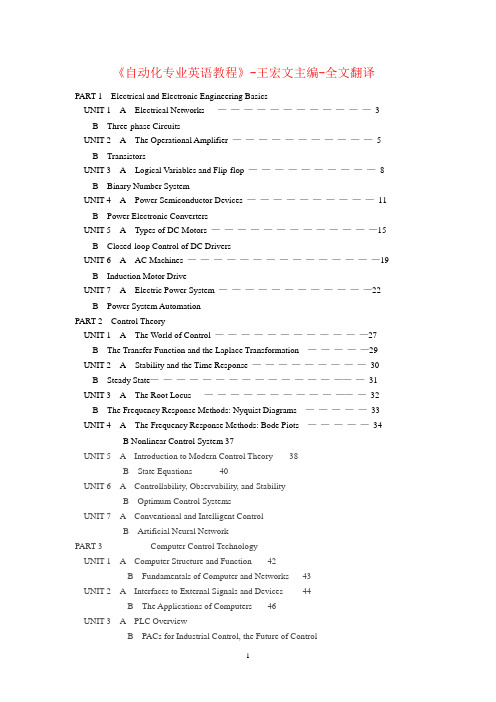
《自动化专业英语教程》-王宏文主编-全文翻译PART 1Electrical and Electronic Engineering BasicsUNIT 1A Electrical Networks ————————————3B Three-phase CircuitsUNIT 2A The Operational Amplifier ———————————5B TransistorsUNIT 3A Logical Variables and Flip-flop ——————————8B Binary Number SystemUNIT 4A Power Semiconductor Devices ——————————11B Power Electronic ConvertersUNIT 5A Types of DC Motors —————————————15B Closed-loop Control of DC DriversUNIT 6A AC Machines ———————————————19B Induction Motor DriveUNIT 7A Electric Power System ————————————22B Power System AutomationPART 2Control TheoryUNIT 1A The World of Control ————————————27B The Transfer Function and the Laplace Transformation —————29 UNIT 2A Stability and the Time Response —————————30B Steady State—————————————————31 UNIT 3A The Root Locus —————————————32B The Frequency Response Methods: Nyquist Diagrams —————33 UNIT 4A The Frequency Response Methods: Bode Piots —————34B Nonlinear Control System 37UNIT 5 A Introduction to Modern Control Theory 38B State Equations 40UNIT 6 A Controllability, Observability, and StabilityB Optimum Control SystemsUNIT 7 A Conventional and Intelligent ControlB Artificial Neural NetworkPART 3 Computer Control TechnologyUNIT 1 A Computer Structure and Function 42B Fundamentals of Computer and Networks 43UNIT 2 A Interfaces to External Signals and Devices 44B The Applications of Computers 46UNIT 3 A PLC OverviewB PACs for Industrial Control, the Future of ControlUNIT 4 A Fundamentals of Single-chip Microcomputer 49B Understanding DSP and Its UsesUNIT 5 A A First Look at Embedded SystemsB Embedded Systems DesignPART 4 Process ControlUNIT 1 A A Process Control System 50B Fundamentals of Process Control 52UNIT 2 A Sensors and Transmitters 53B Final Control Elements and ControllersUNIT 3 A P Controllers and PI ControllersB PID Controllers and Other ControllersUNIT 4 A Indicating InstrumentsB Control PanelsPART 5 Control Based on Network and InformationUNIT 1 A Automation Networking Application AreasB Evolution of Control System ArchitectureUNIT 2 A Fundamental Issues in Networked Control SystemsB Stability of NCSs with Network-induced DelayUNIT 3 A Fundamentals of the Database SystemB Virtual Manufacturing—A Growing Trend in AutomationUNIT 4 A Concepts of Computer Integrated ManufacturingB Enterprise Resources Planning and BeyondPART 6 Synthetic Applications of Automatic TechnologyUNIT 1 A Recent Advances and Future Trends in Electrical Machine DriversB System Evolution in Intelligent BuildingsUNIT 2 A Industrial RobotB A General Introduction to Pattern RecognitionUNIT 3 A Renewable EnergyB Electric VehiclesUNIT 1A 电路电路或电网络由以某种方式连接的电阻器、电感器和电容器等元件组成。
自动化专业外语课本翻译
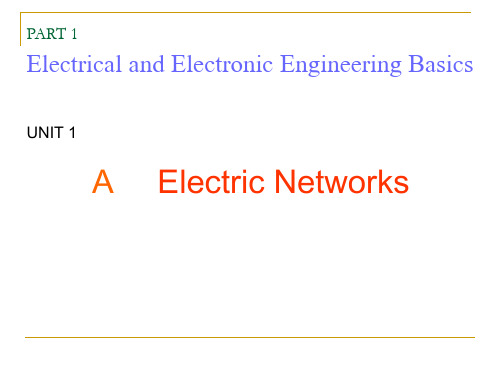
A summary of Eq.(1-1A-1), (11A-2) and (1-1A-4) for the three forms of passive circuit elements is givenentional current flow is used; hence the current in each element is shown in the direction of decreasing voltage.
Using the equations for the voltage drops in a resistor and inductor, we have
di L Ri e dt
Eq.(1-1A-6) is the differential equation for the current in the circuit.
u
dq C
where the capacitance C is the proportionality constant relating voltage and charge.
By definition, current equals the rate of change of charge with time and is expressed as i=dq/dt.
Symbolic representations of voltage and current sources are shown in Fig.1-1A-2.
A common method of analyzing an electrical network is mesh or loop analysis.
Thus an increment of charge dq is equal to the current multiplied by the corresponding time increment, or dq=idt. Eq.(1-1A-3) may then be written as
自动化专业英语原文和翻译

自动化专业英语原文和翻译Automation in the Field of EngineeringIntroduction:Automation plays a crucial role in various industries, including engineering. It involves the use of technology and machines to perform tasks with minimal human intervention. In this article, we will explore the concept of automation in the field of engineering and discuss its significance. Additionally, we will provide an English original text and its translation related to automation in the engineering domain.1. Importance of Automation in Engineering:Automation has revolutionized the engineering sector by enhancing productivity, efficiency, and safety. It eliminates repetitive and mundane tasks, allowing engineers to focus on more complex and critical activities. Automation technology, such as robotics and computer numerical control (CNC) systems, has significantly improved precision and accuracy in manufacturing processes. It also reduces the risk of human errors and enhances overall product quality.2. Applications of Automation in Engineering:Automation finds applications in various engineering disciplines. Some notable examples include:2.1 Industrial Automation:In the manufacturing industry, automation is extensively used to streamline production processes. Automated assembly lines and robotic systems enable faster and more efficient manufacturing. These systems can perform tasks such as material handling, welding, painting, and quality control with high precision and consistency.2.2 Control Systems:Automation is essential in control systems, allowing for the efficient regulation and control of various engineering processes. Programmable Logic Controllers (PLCs) are commonly used to automate industrial processes, ensuring optimal performance and safety. These systems monitor and control parameters such as temperature, pressure, flow rate, and level, thereby maintaining process stability.2.3 Building Automation:In the field of civil engineering, building automation systems are employed to manage and control various building functions. These systems integrate lighting, HVAC (Heating, Ventilation, and Air Conditioning), security, and energy management. By automating these functions, buildings can achieve energy efficiency, occupant comfort, and improved security.2.4 Transportation Automation:Automation has also made significant advancements in the transportation sector. Automated systems, such as traffic control systems and intelligent transportation systems, optimize traffic flow, reduce congestion, and enhance safety. Additionally, automation in vehicles, such as self-driving cars and autonomous drones, holds the potential to revolutionize transportation in the future.3. Challenges and Considerations in Automation:While automation offers numerous benefits, there are challenges that need to be addressed:3.1 Workforce Adaptation:With the increasing adoption of automation, there is a need for the workforce to adapt to new roles and acquire new skills. As certain tasks become automated, engineers must focus on managing and maintaining automated systems, as well as developing new technologies.3.2 Safety and Security:Automation systems must adhere to strict safety standards to prevent accidents and ensure the well-being of workers. Additionally, cybersecurity measures should be implemented to protect automated systems from potential threats and unauthorized access.3.3 Cost and Implementation:The initial cost of implementing automation systems can be significant. However, the long-term benefits, such as increased productivity and reduced operational costs, often outweigh the initial investment. Careful planning and analysis are necessary to ensure a successful and cost-effective implementation.4. English Original Text and Translation:English Original Text:"Automation has revolutionized the engineering industry, enabling faster and more efficient processes. By utilizing advanced technologies and machines, engineers can now focus on complex tasks that require critical thinking and problem-solving skills. Automation not only improves productivity but also enhances product quality and reduces human errors. With the continuous advancements in automation, the engineering field is poised for further growth and innovation."Translation (Chinese):“自动化已经彻底改变了工程行业,实现了更快速、更高效的工艺流程。
自动化专业英语原文和翻译

自动化专业英语原文和翻译Automation in the Field of EngineeringIntroduction:Automation has become an integral part of various industries, including the field of engineering. It involves the use of technology and machines to perform tasks with minimal human intervention. This text aims to provide a comprehensive overview of automation in the engineering field, covering its importance, applications, and future prospects. Additionally, an English translation of the original text will be provided.Importance of Automation in Engineering:Automation plays a crucial role in improving efficiency, accuracy, and productivity in engineering processes. By automating repetitive and time-consuming tasks, engineers can focus on more complex and critical aspects of their work. It also reduces the risk of human errors, leading to higher quality output. Moreover, automation enables engineers to monitor and control systems remotely, enhancing safety and minimizing operational risks.Applications of Automation in Engineering:1. Manufacturing and Assembly: Automation is extensively used in manufacturing industries to streamline production processes. Automated systems can perform tasks such as assembly, welding, and material handling with precision and speed. This leads to increased production rates, reduced costs, and improved product quality.2. Robotics: Robotics is a significant application of automation in engineering. Robots are used in various sectors, including automotive, healthcare, and aerospace industries. They can perform complex tasks with high accuracy, consistency, and repeatability. Examples include robotic arms used in assembly lines and surgical robots in medical procedures.3. Control Systems: Automation is vital in control systems, which regulate and optimize various engineering processes. Programmable Logic Controllers (PLCs) and Distributed Control Systems (DCS) are commonly used to automate tasks such as temperature control, pressure regulation, and flow management. This ensures efficient operation and minimizes manual intervention.4. Energy Management: Automation plays a crucial role in energy management systems, optimizing energy consumption and reducing waste. Automated systems can monitor and control energy usage in buildings, factories, and power plants. This leads to energy savings, cost reduction, and environmental sustainability.Future Prospects of Automation in Engineering:The future of automation in engineering looks promising, with several emerging trends and technologies. Some of these include:1. Artificial Intelligence (AI): AI is revolutionizing automation by enabling machines to learn, adapt, and make decisions. Machine Learning algorithms can analyze vast amounts of data to optimize processes and predict failures. AI-powered systems can also perform complex tasks that were previously only possible for humans.2. Internet of Things (IoT): IoT connects various devices and systems, allowing them to communicate and share data. In engineering, IoT enables remote monitoring, predictive maintenance, and real-time data analysis. This leads to improved efficiency, reduced downtime, and enhanced decision-making.3. Digital Twin: A digital twin is a virtual replica of a physical system or process. It allows engineers to simulate and optimize operations, predict performance, and identify potential issues. Digital twins enable engineers to make informed decisions and improve system performance.4. Cybersecurity: As automation becomes more prevalent, ensuring the security of automated systems is crucial. Cybersecurity measures are essential to protect against potential threats and vulnerabilities. This includes implementing secure communication protocols, encryption techniques, and access control mechanisms.Translation:自动化在工程领域的应用介绍:自动化已成为包括工程领域在内的各个行业的重要组成部分。
自动化专业外语第三版部分翻译
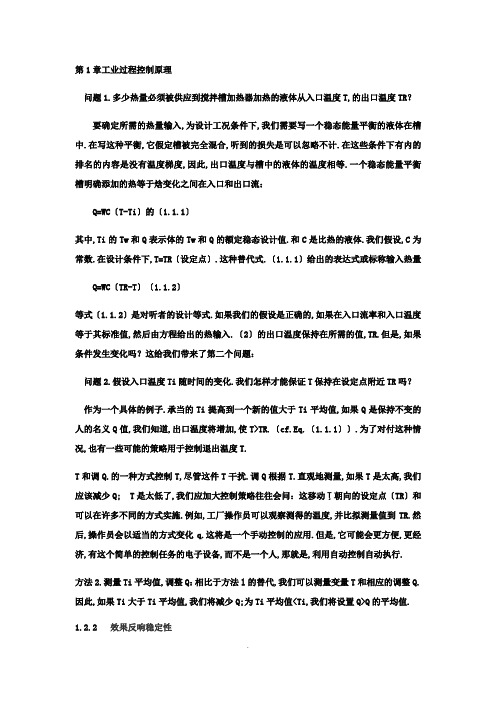
第1章工业过程控制原理问题1.多少热量必须被供应到搅拌槽加热器加热的液体从入口温度T,的出口温度TR?要确定所需的热量输入,为设计工况条件下,我们需要写一个稳态能量平衡的液体在槽中.在写这种平衡,它假定槽被完全混合,听到的损失是可以忽略不计.在这些条件下有内的排名的内容是没有温度梯度,因此,出口温度与槽中的液体的温度相等.一个稳态能量平衡槽明确添加的热等于焓变化之间在入口和出口流:Q=WC〔T-Ti〕的〔1.1.1〕其中,Ti的Tw和Q表示体的Tw和Q的额定稳态设计值.和C是比热的液体.我们假设,C为常数.在设计条件下,T=TR〔设定点〕.这种替代式.〔1.1.1〕给出的表达式或标称输入热量Q=WC〔TR-T〕〔1.1.2〕等式〔1.1.2〕是对听者的设计等式.如果我们的假设是正确的,如果在入口流率和入口温度等于其标准值,然后由方程给出的热输入.〔2〕的出口温度保持在所需的值,TR.但是,如果条件发生变化吗?这给我们带来了第二个问题:问题2.假设入口温度Ti随时间的变化.我们怎样才能保证T保持在设定点附近TR吗?作为一个具体的例子.承当的Ti提高到一个新的值大于Ti平均值,如果Q是保持不变的人的名义Q值,我们知道,出口温度将增加,使T>TR.〔cf.Eq.〔1.1.1〕〕.为了对付这种情况,也有一些可能的策略用于控制退出温度T.T和调Q.的一种方式控制T,尽管这件T干扰.调Q根据T.直观地测量,如果T是太高,我们应该减少Q; T是太低了,我们应加大控制策略往往会问:这移动Ţ朝向的设定点〔TR〕和可以在许多不同的方式实施.例如,工厂操作员可以观察测得的温度,并比拟测量值到TR.然后,操作员会以适当的方式变化q.这将是一个手动控制的应用.但是,它可能会更方便,更经济,有这个简单的控制任务的电子设备,而不是一个人,那就是,利用自动控制自动执行.方法2.测量Ti平均值,调整Q:相比于方法l的替代,我们可以测量变量T和相应的调整Q.因此,如果Ti大于Ti平均值,我们将减少Q;为Ti平均值<Ti,我们将设置Q>Q的平均值.1.2.2 效果反响稳定性1. 稳定性是描述系统是否能够跟踪输入命令或是否有用的概念2. 非严格地,如果一个系统的输出失去了控制,我们就说它是不稳定的3. 为了研究反响对稳定性的影响,我们可以再次观察等式〔1〕.如果GH=-1〔称为负一〕,对于任何输入,系统的输出都是无穷大,这样的系统是不稳定的4. 因此,我们说反响可以使原来稳定的系统变得不稳定5. 当然,反响是一柄双刃剑,当使用不当时,将会产生坏的作用6. 然而需要指出的是,我们在这里只针对静态情况,而通常GH=-1不是系统不稳定的唯一条件.可以证明,参加反响的好处之一是能够使不稳定的系统稳定.我们假设图所示的反响系统是不稳定的,因为GH=-1.如果我们引入另一反响环,其负反响增益是F,如以下图,系统总的输入/输出关系是1.很明显,尽管G和H使内环反响系统不稳定,因为GH=-1,而如果正确选择外环的反响增益F,系统总体上能够是稳定的.2.在实践中,GH是频率的函数,并且闭环系统的稳定性条件依赖于GH的幅值和相位.结论是反响能够改良系统的稳定性,但如果使用不当,也有可能破坏稳定性.1.2.3. 反响对灵敏度的影响1.控制系统中对灵敏度的考虑是非常重要的.由于所有的物理元素都有随环境和时间变化的特性,在系统的整个运行过程中,我们不可能把控制系统的参数当作完全静态的.2.例如,马达的线圈电阻会随着马达温度的升高而变化.第1章中的电子打字机在第一次开机时有时会运行不正常,因为系统参数在预热期间发生变化.3.这种现象有时被称为 "早困〞.大多数复印机都有预热时间,在初次打开后运行会闭锁.1.总的来说,一个好的控制系统应当对参数的变化很不灵敏,而对输入命令的响应很灵敏.我们来研究对参数变化的灵敏度,反响将会产生何种影响.在图1.2.1中,我们考虑G是变化的增益参数.对于G的变化,系统的总的增益灵敏度M定义为M表示由G的微小变化量偏G造成的M的微小变化量.应用〔1〕式,灵敏度函数可以写成GH是正的常数,在系统保持稳定的前提下,灵敏度函数的幅值可以通过增大GH变得任意小.很明显,在开环系统中,系统的增益对G来说是一比一的形式〔即SMG =1〕.2.我们再次提醒,在实践中,GH是频率的函数,在某些频率X围内,1+GH的幅值有可能小于1,这使得在某些情况下,反响对参数灵敏度是有害的.3.通常,反响系统增益对参数的灵敏度取决于参数的位置.读者可以得到图中由于H的变化而造成的灵敏度.1.但是,最初的设计极少能够满足所有目标,通常情况下需要对方法的某些方面做一些修改.基于对最初设计缺陷的理解,有可能必须改变控制的硬件.例如,有可能必须要增加"工作X围〞,象执行器的最大动力水平,或增加额外的传感器.1.另一方面,〔我们〕有可能发现最初使用的设计方法是不恰当的.举一个例子,基于连续时间控制的设计方案打算用数字元件来逼近实现之后〔我们〕发现更好的方法,采用离散时间设计方案,可以直接用数字元件实现2.做出正确的调整之后,在设计过程中相应的步骤还需要重复很屡次,直到达到理想的目标.1.有时,你必须接受失败:用各种不同的软硬件组合方法进行了重复设计之后,结论却是你不知该如何设计这个系统使其满足需求.2.你只能报告说,尽你最大的知识和能力,要满足性能需求,就必须要在硬件或方法学上有所突破-即还不存在的发明.1.正如你所见到的,对控制算法的选择通常只是整个设计过程的一小局部.经验告诉我们,控制算法不会成为影响整个系统性能的决定性因素2.如果你成功地设计了一个系统〔采用任何方法〕,并使之运行,那么单靠不同的控制算法不能在提高性能和降低本钱上取得较大层次的成功.然而,取得较低级别的改良也是有意义的,是值得追求的.1.除非你熟悉一些标准的设计方案和传统的设计方法,否如此你可能无法应付不熟悉的过程.例如,考虑控制飞机的运行问题,在受到一系列不同约束的条件下使其从一个起点到一个指定目的地,如准许的飞行轨道、可用的燃油、安全等2.〔这类问题的具体实例包括人工驾驶飞机,巡航导弹和遥控飞行器等.毫无疑问,每一个都和其它应用在细节上大不一样〕.尽管大部分的飞行控制问题都已经被解决了,但在思索如何处理一些你事先不知解决方法的问题上仍具有启发性.1.原如此上,飞行控制问题可以被表述成一个通用的优化问题:在数学约束X围内,最小化一个指定的数学性能指标.但在在实践中,这种方法几乎是注定失败的,有很多原因,包括以下方面:强调反响控制是一项重要的技术过程工业.它的主要优点是1.一旦控制变量偏离了设置点,无论源和类型的扰动,就会发生纠正操作.2.它需要对控制过程的最小了解,特别是a 虽然它对控制系统的设计很有用,但是不需要对流程进展建模.3.无所不在的PID控制器既通用又健壮.如果工艺条件改变, 重新调整控制器通常会产生令人满意的控制.反响控制也有一些固有的缺点1.在控制变量发生偏差后才采取纠正措施. 因此,完全控制,控制变量不会偏离设定值在负载或设置点更改时,理论上是不可能的.2.它不提供预测控制行动来补偿或可测量干扰的影响.3.对于具有大量时间常量和/或长时间延迟的进程可能不令人满意. 如果发生大且频繁的扰动,该过程可能会持续处于短暂状态,且永远无法达到所需的稳态.4.在某些应用中,控制变量无法在线测量反响控制是不可行的.情况下,反响控制本身并不令人满意,显著改良控制可以通过增加前馈控制.但使用前馈控制,干扰必须在线测量<或估计>.在这个单位.我们考虑了前馈控制系统的设计和分析.我们首先概述前馈控制和比例控制,这是一种特殊的前馈控制.接下来介绍了.如果一个过程在一系列的条件下操作,可以通过使用一组不同的控制器设置来控制每一个操作条件.或者,可以在控制器设置和描述流程条件的流程变量之间建立关系.这些策略是编程适应的例子.编程适应仅限于应用程序,过程动力学依赖于的、可测量的变量和必要的控制器调整并不是太复杂,通常是适应在结构上是否足够简单,可以用一些模拟和所有数字实现控制器.最受欢迎的编程方式是增益调度,控制器增益调整,从而使开环增益K保持不变.作为一个控制问题的例子,规划的适应已经被提出, 考虑一个直流锅炉.这里的给水经过一系列加热管局部在产生过热蒸汽之前,必须准确控制温度.给水流量对锅炉的稳态和动态性能有显著的影响.例如,图3所示.3.1显示了典型的开环反响流量阶跃变化,最大流量的50%和100%.假设一个经验的一阶加时延模型被选择来近似这个过程.稳态增益,延时,和占主导的时间常数是50%流量的两倍,相当于100%流量的相应值.这个控制问题的解决方案是使PID控制器的设置随w的不同而变化,即整个流量的比例<0 w 1>,以如下方式其中K D是100%流量的控制器设置.请注意,对编程适应的建议在质量上与Cohen和Coon规如此的协调一致,并假设流变化的影响与整个操作的流速率成比例关系. 在这个示例中,可以根据两个不同的条件对流程行为进展分类.在其他问题中,动态响应数据是不可用的,但我们对过程非线性有一定的了解.对于含有强酸和/或强碱的酸碱问题,pH值曲线可能非常非线性,在多个数量级上都有变化.因此,针对pH控制问题开展了特殊的非线性控制器,无论是适应性的还是非适应性的.在这种情况下,过程会随着操作条件的变化而变化,因此需要使用增益调度<KcKp =常量>来维护一致的稳定利润.对于某些类型的自适应控制问题,稳态和动态响应特征的变化可以与控制变量的值有关.例如,在温度控制回路中,过程增益随温度的变化而变化,控制器增益可以被控制变量的函数,温度.反响控制器现在是商业性的,它允许用户将Kc作为错误信号e的分段线性函数,如图3所示.3.2.如果进程获得Kp以的方式变化,那么我们应该改变Kc,以便产品KcKp是常量.这种策略将使开环增益保持不变,从而保持一定的稳定性<假设过程动态不变>直流电机是当今工业中使用最广泛的主要动力之一.多年前,大多数用于控制目的的小型伺服马达都是ac 品种.实际上,交流电动机更难控制,尤其是对位置控制和它们的控制特征是非线性的,这使得分析任务更加困难.直流电机,另一方面,更昂贵,因为刷换向片,变磁力线只适合某些类型的直流电机控制的应用程序.在永磁<PM>远非理想.今天,随着稀土磁铁的开展,可以实现非常高的转矩,单位体积,或质量直流电机以合理的本钱.此外,电刷整流器技术的进步使得这些耐磨部件几乎不需维护的.电力电子的进步使无刷直流电机在高性能控制系统中非常流行.先进的制造技术也产生了无铁转子具有非常低惯性的直流电机,从而实现了非常高的扭矩-惯性比,以与低时不变的性能在计算机外围设备,如磁带驱动器,打印机,磁盘驱动器,文字处理器,以与自动化和机床工业中,为直流电机打开新的应用程序5.2.1直流电机的根本操作原理直流电机根本上是一个扭矩传感器,将电能转换成机械能量.电机轴上的力矩与场通量和电枢电流成正比.如图5所示.2.1载流导体是在a中建立的磁通量Q的磁场,导线位于旋转中心的距离r.开发了转矩之间的关系,流量Q,和当前Ia Tm = KmQia<5.2.1> Tm是电动机转矩<n - m、磅英尺或扭力>,问的磁通量<韦伯夫妇>,ia的电枢电流<安培>,和公里是一个比例常数. 除了图5所示的排列所产生的力矩之外.2.1,当导体在磁场中移动,在其端子上产生电压.这个电压,emf,轴速度成正比,倾向于反对电流.20世纪60年代早期,工业机器人成为了现实,约瑟夫·恩格尔伯格和乔治 Devol 联合成立了一个名为"Unimation〞的机器人公司.Engelberger和Devol并不是第一个梦想机器可以执行的机器在制造不熟练,重复的工作.第一次使用"机器人〞这个词是由捷克斯洛伐克哲学家、剧作家卡雷尔·卡佩克<Karel Capek>扮演r . u<Rossum的通用机器人>."机器人〞一词在捷克意味着"工人〞或"奴隶.这出戏是1922年写的.在Capek的游戏中,Rossum和他的儿子发现了人造原生质的化学配方.原生质构成生命的根底.用他们的化合物,Rossum和他的儿子制造一个机器人.Rossum和他的儿子花了20年的时间把原生质变成了一个机器人.二十年后的ros总和看着他们创造的东西说:"如果我们不能让他比大自然快,那么花20年的时间来做一个男人是荒谬的,你也可以闭嘴.〞年轻的Rossum回到工作中去去除他认为对理想工作者没有必要的器官.年轻的Rossum说:"一个人的感觉是快乐的,玩耍钢琴,喜欢散步,实际上想做很多事情不必要的…但是工作机器不能弹钢琴,不能感到快乐,千万不能做还有很多其他的东西.任何不能直接促进工作进展的事情都应该被消除.半个世纪后,工程师开始建造Rossum的机器人,而不是人工原生质, 但是硅水力学,气,和电动机.那些在1922年被卡佩克所梦想的机器人,它的工作,但是没有感觉,在制造工厂里执行非人类或人类的工作,在世界各地都是可行的. 就像Rossum的儿子认为的那样,现代机器人缺乏感觉和情感.它可以只简单回应"是/否〞问题.现代机器人通常被栓在地板上.它有一只胳膊和一只手.这是又聋又瞎又哑.尽管有各种各样的障碍,现代机器人仍然在不无聊或抱怨的情况下完成分配的任务.机器人不仅仅是另一台自动化机器.自动化开始于工业革命期间,机器完成了以前由人类工人完成的工作.然而,这种机器只能做它设计的具体工作,近年来,人们对为各种各样的科学和工程应用开发人工智能<AI>技术有着浓厚的兴趣.一份全面的调查报告提供了对过程工程中的智能系统的彻底审查,并包含385个参考文献.该领域的过程控制研究主要涉与三个人工智能方法:基于知识的系统、神经网络和模糊逻辑. 6.1.1以知识为根底的系统基于知识的系统<KBS>,也称为专家系统.使用一组"规如此〞对流程操作或其他活动的状态进展逻辑推断的兴趣.一个早期的、高度可见的示X项目"猎鹰计划〞是杜邦公司的合作项目.在1983 - 1987年间,Foxboro和特拉华大学.本研究的目的是开发并应用基于知识的方法,在一种全面的化学工厂,一种油质的酸转换器中进展故障诊断.尽管这个开创性的项目被认为只是局部成功,但它为许多未来的杜邦KBS应用铺平了道路.Stephanopoulos和Han指出,KBS系统的工业应用根本上是这样的关注诊断和监测活动或监视控制.监控应用程序包括以下问题:复杂的控制方案;从极端环境中恢复;以与紧急关闭.他们还描述了一些工业KBS应用程序. Samdani和Fouhy最近的一篇贸易杂志文章概述了KBS在流程工业中的应用.他们报告说,"……杜邦很清楚地从1000个左右的KBS中获得了好处.在同样的问题上,Samdani报告说, "<杜邦>说,还有大约2万个应用领域有待开发.〞。
自动化专业英语课文翻译1.2

Lesson 1.2 What is Feedback and What are Its Effects?•The motivation of using feedback, illustrated (说明) by the examples in Section (1), is somewhat oversimplified.第一节事例中,应用反馈的动机有些过于简单•In these examples, the use of feedback is shown to be for the purpose of reducing the error between the reference input and the system output.在这些例子中,应用反馈的目的是减小参考输入和系统输出间的误差•However, the significance of the effects of feedback in control systems is more complex than is demonstrated by these simple examples.然而,在控制系统中应用反馈的重要性要比这些简单例子所示的复杂得多•The reduction of system error is merely (仅仅) one of the many important effects that feedback may have upon a system.减少系统误差只是反馈对系统产生的重要作用之一•We show in the following sections that feedback also has effects on such system performance characteristics as stability (稳定性), bandwidth (带宽), overall gain (总增益), disturbance (扰动), and sensitivity (灵敏度).在下面的章节里,反馈还能对系统的下列运行特性产生影响:稳定性,带宽,总增益,扰动和灵敏度•To understand the effects of feedback on a control system, it is essential that we examine this phenomenon in a broad sense.为了理解反馈对控制系统的作用,我们需要从广义的角度来检验这个现象•When feedback is deliberately (有意地) introduced for the purpose of control, its existence is easily identified.当反馈被有意地引入控制中时,(我们可以)很容易地识别出它来•However, there are numerous situations wherein (在什么地方) a physical system that we normally recognize as an inherently non-feedback system turn out to have feedback when it is observed in a certain manner.但是在很多情况下,我们通常认为的本质上非反馈的物理系统,在某些特定的观察方式下,也会表现出反馈的特性•In general, we can state that whenever a closed sequence of cause-and-effect relationships (因果关系) exists among the variables of a system, feedback is said to exist.一般来说,每当系统变量间存在一个有因果关系的闭路序列时,我们可以说系统存在反馈•The viewpoint will inevitably (不可避免地) admit feedback in a large number of systems that ordinarily would be identified as nonfeedback systems.这种观点不可避免地承认了大量的最初被认为是非反馈系统的系统都存在反馈•However, with the availability (有效性,可用性) of the feedback and control system theory, this general definition of feedback enables numerous systems,•with or without physical feedback, to be studied in a systematic way once the existence of feedback in the sense mentioned previously is established.随着反馈和控制理论的应用,一旦上述意义上的反馈的存在被建立,这种通用的反馈定义可以使大量的系统得到更系统化的研究,而不管有没有物理上的反馈。
自动化专业英语原文和翻译

自动化专业英语原文和翻译Automation in the field of engineering has revolutionized various industries, making processes more efficient and reducing human error. As a result, there is a growing demand for professionals who are well-versed in automation technologies and can communicate effectively in English. In this text, we will provide a standard format for an original English text and its translation in the field of automation.Original English Text:Title: Automation in Manufacturing ProcessesIntroduction:Automation has become an integral part of manufacturing processes, with the aim of improving productivity, reducing costs, and ensuring consistent quality. This article explores the various aspects of automation in manufacturing and its impact on the industry.1. Definition of Automation:Automation refers to the use of technology and control systems to operate and control machinery and processes without human intervention. It involves the use of sensors, actuators, and computer systems to perform tasks that were previously carried out by humans.2. Benefits of Automation in Manufacturing:- Increased productivity: Automation allows for faster and more efficient production processes, leading to higher output and reduced lead times.- Cost reduction: By automating repetitive tasks, companies can reduce labor costs and minimize the risk of human error.- Improved quality control: Automation ensures consistent product quality by eliminating variations caused by human factors.- Enhanced safety: Dangerous tasks can be automated, reducing the risk of accidents and injuries in the workplace.3. Types of Automation in Manufacturing:a. Fixed Automation:Fixed automation involves the use of specialized machinery designed for a specific task or product. It is suitable for high-volume production with little or no variation in product design.b. Programmable Automation:Programmable automation utilizes computer-controlled systems that can be easily reprogrammed to perform different tasks or produce various products. It is suitable for medium-volume production with some level of product variation.c. Flexible Automation:Flexible automation combines the advantages of fixed and programmable automation. It involves the use of computer-controlled systems that can be reprogrammed to handle a wide range of products and tasks. It is suitable for low-volume production with high product variation.4. Challenges in Implementing Automation:While automation offers numerous benefits, its implementation can pose challenges. Some common challenges include:- High initial investment: Automation systems can be expensive to implement, requiring significant capital investment.- Workforce transition: Automation may lead to job displacement, requiring companies to provide retraining opportunities for affected employees.- Technical complexity: Implementing automation systems requires specialized knowledge and expertise, which may not be readily available.- Integration with existing systems: Integrating automation systems with existing machinery and processes can be complex and time-consuming.Conclusion:Automation has transformed manufacturing processes, offering increased productivity, cost reduction, improved quality control, and enhanced safety. Understanding the different types of automation and the challenges involved in its implementation is crucial for professionals in the field. As the demand for automation specialists continues to grow, proficiency in English communication is essential for effective collaboration and knowledge sharing in the global industry.Translation (Chinese):标题:制造过程中的自动化介绍:自动化已成为制造过程的重要组成部分,旨在提高生产效率,降低成本,并确保一致的质量。
自动化专业英语原文和翻译

自动化专业英语原文和翻译Title: Automation in the Field of EngineeringIntroduction:Automation has revolutionized various industries, including engineering, by streamlining processes and increasing efficiency. This text provides a detailed overview of automation in the field of engineering, discussing its significance, applications, and benefits. Additionally, a translation of the original English text into Chinese is provided below.1. Significance of Automation in Engineering:Automation plays a crucial role in the field of engineering as it enables the use of advanced technologies to optimize processes and enhance productivity. By automating repetitive tasks, engineers can focus on more complex and innovative projects, leading to improved overall performance.2. Applications of Automation in Engineering:2.1 Industrial Automation:Industrial automation involves the use of control systems and technologies to operate various machinery and processes in manufacturing plants. It includes tasks such as assembly line automation, material handling, and quality control. Automation in this sector leads to increased production rates, improved product quality, and reduced labor costs.2.2 Robotics and Artificial Intelligence (AI):Robots and AI have revolutionized engineering by performing tasks that were previously done by humans. These technologies are employed in various fields, such as manufacturing, healthcare, and transportation. Robotic automation enhances precision, reduces human error, and ensures worker safety.2.3 Process Automation:Process automation involves the use of software and systems to streamline and manage complex engineering processes. It includes tasks such as data analysis, simulation, and optimization. Automation in this area improves accuracy, reduces time-consuming manual tasks, and enhances decision-making.2.4 Energy and Environmental Automation:Automation in the energy sector focuses on optimizing energy consumption and reducing environmental impact. It includes smart grid systems, energy management, and renewable energy technologies. Automation in this field leads to energy efficiency, cost savings, and a greener environment.3. Benefits of Automation in Engineering:3.1 Increased Efficiency and Productivity:Automation eliminates time-consuming manual tasks, reducing human error and increasing overall efficiency. It allows engineers to focus on more critical aspects of their work, leading to improved productivity and faster project completion.3.2 Cost Reduction:By automating processes, companies can reduce labor costs, minimize waste, and optimize resource utilization. Automation also helps in preventing errors that can lead to costly rework or product recalls.3.3 Improved Safety:Automation in engineering ensures worker safety by replacing humans in hazardous or physically demanding tasks. Robots and AI can perform tasks in dangerous environments, reducing the risk of accidents and injuries.3.4 Enhanced Quality and Accuracy:Automation improves product quality by reducing human error and variability. It ensures consistent and precise execution of tasks, resulting in higher-quality products and services.3.5 Innovation and Competitiveness:By automating routine tasks, engineers can dedicate more time to innovation and research. This leads to the development of new technologies, products, and services, enhancing a company's competitiveness in the market.Conclusion:Automation has significantly impacted the field of engineering by revolutionizing various aspects of the industry. From industrial automation to robotics and AI, the benefits of automation are extensive, including increased efficiency, cost reduction, improved safety, enhanced quality, and fostering innovation. Embracing automation in engineering is crucial for companies to stay competitive in today's rapidly evolving technological landscape.Translation (Chinese):自动化在工程领域的应用引言:自动化通过优化流程和提高效率,彻底改变了包括工程在内的各个行业。
自动化专业英语教程(王宏文)第二版全文翻译
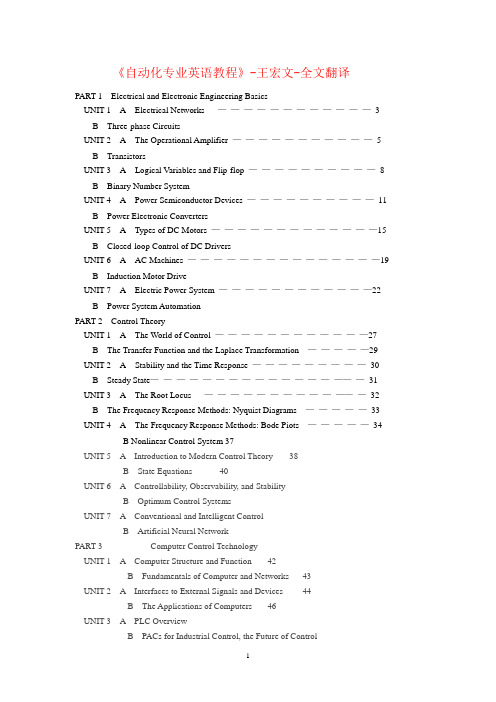
《自动化专业英语教程》-王宏文-全文翻译PART 1Electrical and Electronic Engineering BasicsUNIT 1A Electrical Networks ————————————3B Three-phase CircuitsUNIT 2A The Operational Amplifier ———————————5B TransistorsUNIT 3A Logical Variables and Flip-flop ——————————8B Binary Number SystemUNIT 4A Power Semiconductor Devices ——————————11B Power Electronic ConvertersUNIT 5A Types of DC Motors —————————————15B Closed-loop Control of DC DriversUNIT 6A AC Machines ———————————————19B Induction Motor DriveUNIT 7A Electric Power System ————————————22B Power System AutomationPART 2Control TheoryUNIT 1A The World of Control ————————————27B The Transfer Function and the Laplace Transformation —————29 UNIT 2A Stability and the Time Response —————————30B Steady State—————————————————31 UNIT 3A The Root Locus —————————————32B The Frequency Response Methods: Nyquist Diagrams —————33 UNIT 4A The Frequency Response Methods: Bode Piots —————34B Nonlinear Control System 37UNIT 5 A Introduction to Modern Control Theory 38B State Equations 40UNIT 6 A Controllability, Observability, and StabilityB Optimum Control SystemsUNIT 7 A Conventional and Intelligent ControlB Artificial Neural NetworkPART 3 Computer Control TechnologyUNIT 1 A Computer Structure and Function 42B Fundamentals of Computer and Networks 43UNIT 2 A Interfaces to External Signals and Devices 44B The Applications of Computers 46UNIT 3 A PLC OverviewB PACs for Industrial Control, the Future of ControlUNIT 4 A Fundamentals of Single-chip Microcomputer 49B Understanding DSP and Its UsesUNIT 5 A A First Look at Embedded SystemsB Embedded Systems DesignPART 4 Process ControlUNIT 1 A A Process Control System 50B Fundamentals of Process Control 52UNIT 2 A Sensors and Transmitters 53B Final Control Elements and ControllersUNIT 3 A P Controllers and PI ControllersB PID Controllers and Other ControllersUNIT 4 A Indicating InstrumentsB Control PanelsPART 5 Control Based on Network and InformationUNIT 1 A Automation Networking Application AreasB Evolution of Control System ArchitectureUNIT 2 A Fundamental Issues in Networked Control SystemsB Stability of NCSs with Network-induced DelayUNIT 3 A Fundamentals of the Database SystemB Virtual Manufacturing—A Growing Trend in AutomationUNIT 4 A Concepts of Computer Integrated ManufacturingB Enterprise Resources Planning and BeyondPART 6 Synthetic Applications of Automatic TechnologyUNIT 1 A Recent Advances and Future Trends in Electrical Machine DriversB System Evolution in Intelligent BuildingsUNIT 2 A Industrial RobotB A General Introduction to Pattern RecognitionUNIT 3 A Renewable EnergyB Electric VehiclesUNIT 1A 电路电路或电网络由以某种方式连接的电阻器、电感器和电容器等元件组成。
自动化专业英语原文和翻译

自动化专业英语原文和翻译Automation in the Field of EngineeringIntroduction:Automation plays a crucial role in the field of engineering, revolutionizing the way tasks are performed and increasing efficiency. This article aims to discuss the significance of automation in engineering, its benefits, and its impact on various industries. Furthermore, it provides an English original text and its translation in Chinese related to automation in the engineering profession.Benefits of Automation in Engineering:1. Increased Efficiency: Automation reduces the need for manual labor, thereby enhancing productivity and efficiency. Tasks that previously required significant time and effort can now be completed quickly and accurately through automated processes.2. Improved Safety: Automation eliminates the need for human intervention in hazardous environments, reducing the risk of accidents and injuries. Robots and machines can perform tasks that are dangerous for humans, ensuring a safer working environment.3. Cost Reduction: By automating repetitive tasks, companies can minimize labor costs and allocate resources more effectively. Automation also reduces the chances of errors, resulting in cost savings associated with rework or product recalls.4. Enhanced Accuracy and Precision: Automation ensures consistent and precise results, eliminating human errors that may occur due to fatigue or lack of concentration. This is particularly crucial in industries where precision is vital, such as manufacturing and quality control.5. Increased Productivity: Automation allows engineers to focus on complex tasks that require human expertise, while routine and repetitive tasks are handled by machines.This leads to increased productivity and enables engineers to utilize their skills and knowledge more effectively.Impact of Automation in Various Industries:1. Manufacturing Industry: Automation has revolutionized the manufacturing sector by streamlining production processes and improving efficiency. Robots and automated assembly lines have significantly increased production rates and reduced costs.2. Automotive Industry: Automation has transformed the automotive industry, enabling the production of high-quality vehicles with minimal errors. Automated systems are used in various stages, including assembly, painting, and quality control.3. Aerospace Industry: Automation plays a crucial role in the aerospace industry, where precision and safety are paramount. Automated systems are used in aircraft manufacturing, maintenance, and even space exploration.4. Healthcare Industry: Automation has improved patient care and medical procedures in the healthcare industry. Automated devices are used for diagnostics, surgery, and monitoring, leading to more accurate and efficient treatments.5. Energy Sector: Automation has revolutionized the energy sector, particularly in power generation and distribution. Automated systems are used in power plants, renewable energy facilities, and smart grids, ensuring efficient energy management.English Original Text:Automation has become an integral part of the engineering profession, transforming various industries and revolutionizing the way tasks are performed. The benefits of automation in engineering are manifold. Firstly, it significantly increases efficiency by reducing the need for manual labor. Tasks that were once time-consuming and labor-intensive can now be completed quickly and accurately through automated processes. Secondly, automation improves safety by eliminating the need for human intervention in hazardous environments. Robots and machines can perform tasks that are dangerous for humans, ensuring a safer working environment. Additionally, automation leads to costreduction by minimizing labor costs and reducing the chances of errors, which can be costly to rectify. Moreover, automation enhances accuracy and precision, eliminating human errors that may occur due to fatigue or lack of concentration. This is particularly crucial in industries where precision is vital, such as manufacturing and quality control. Lastly, automation increases productivity by allowing engineers to focus on complex tasks that require human expertise, while routine and repetitive tasks are handled by machines.Translation in Chinese:自动化已成为工程专业的重要组成部分,改变了各行各业的工作方式,实现了任务的革命性变革。
自动化专业英语原文和翻译
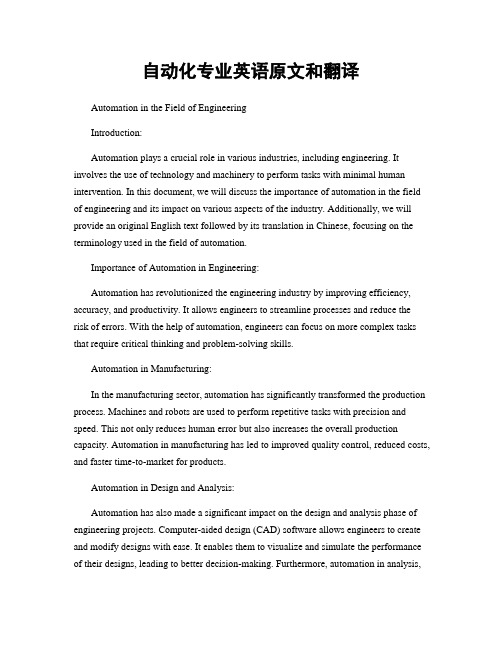
自动化专业英语原文和翻译Automation in the Field of EngineeringIntroduction:Automation plays a crucial role in various industries, including engineering. It involves the use of technology and machinery to perform tasks with minimal human intervention. In this document, we will discuss the importance of automation in the field of engineering and its impact on various aspects of the industry. Additionally, we will provide an original English text followed by its translation in Chinese, focusing on the terminology used in the field of automation.Importance of Automation in Engineering:Automation has revolutionized the engineering industry by improving efficiency, accuracy, and productivity. It allows engineers to streamline processes and reduce the risk of errors. With the help of automation, engineers can focus on more complex tasks that require critical thinking and problem-solving skills.Automation in Manufacturing:In the manufacturing sector, automation has significantly transformed the production process. Machines and robots are used to perform repetitive tasks with precision and speed. This not only reduces human error but also increases the overall production capacity. Automation in manufacturing has led to improved quality control, reduced costs, and faster time-to-market for products.Automation in Design and Analysis:Automation has also made a significant impact on the design and analysis phase of engineering projects. Computer-aided design (CAD) software allows engineers to create and modify designs with ease. It enables them to visualize and simulate the performance of their designs, leading to better decision-making. Furthermore, automation in analysis,such as finite element analysis (FEA), helps engineers predict the behavior of structures and systems under different conditions, ensuring safety and reliability.Automation in Construction:The construction industry has also embraced automation to enhance efficiency and safety. Robotic systems are used for tasks such as bricklaying, concrete pouring, and welding. These systems can work continuously without fatigue and perform tasks with precision, reducing the risk of accidents. Additionally, automation in construction allows for better project management, improved resource utilization, and faster completion times.Automation in Maintenance and Monitoring:Automation has revolutionized the field of maintenance and monitoring in engineering. Sensors and monitoring systems are used to collect real-time data on the performance of machines and structures. This data is then analyzed using automation techniques to detect anomalies and predict failures. By implementing proactive maintenance strategies based on automation, engineers can prevent costly breakdowns, minimize downtime, and optimize the lifespan of assets.Automation Terminology - English and Chinese Translation:Original English Text:1. Programmable Logic Controller (PLC): A digital computer used for automation of electromechanical processes.2. Human-Machine Interface (HMI): A graphical user interface that allows operators to interact with automation systems.3. Supervisory Control and Data Acquisition (SCADA): A system used for remote monitoring and control of industrial processes.4. Distributed Control System (DCS): A control system used to manage and control complex processes in various industries.5. Internet of Things (IoT): The network of physical devices, vehicles, and other objects embedded with sensors, software, and connectivity.Chinese Translation:1. 可编程逻辑控制器(PLC):用于电机电子过程自动化的数字计算机。
自动化专业英语原文和翻译

自动化专业英语原文和翻译Automation in the Field of EngineeringIntroduction:Automation plays a crucial role in various industries, including engineering. As a result, proficiency in both English and technical knowledge is essential for professionals in the field of automation. This article will provide an original text and its translation in English, focusing on the importance of automation in engineering.Original Text:自动化是一种通过使用计算机技术和控制系统来实现自动操作和控制的技术。
在工程领域,自动化被广泛应用于诸如创造、能源、交通、通信等各个方面。
自动化技术的发展使得工程师能够更高效地完成任务,提高生产效率,并减少了人为错误的发生。
自动化系统可以用于监控和控制各种设备和过程,从而实现自动化生产线、智能交通系统和智能家居等应用。
自动化在工程领域的应用非常广泛。
例如,在创造业中,自动化系统可以用于自动装配和生产线控制,从而提高产品质量和生产效率。
在能源领域,自动化系统可以用于监控和控制发电厂的运行,实现能源的高效利用。
在交通领域,自动化技术可以应用于智能交通信号灯控制和车辆导航系统,提高交通效率和安全性。
在通信领域,自动化系统可以用于网络管理和故障诊断,确保通信网络的稳定运行。
自动化专业英语翻译:Automation is a technology that enables automatic operations and control through the use of computer technology and control systems. In the field of engineering, automation finds extensive applications in various sectors such as manufacturing, energy, transportation, and communication. The development of automation technology allows engineers to efficiently complete tasks, enhance productivity, and reduce human errors. Automation systems can be used for monitoring and controlling various devices andprocesses, enabling applications such as automated production lines, intelligent transportation systems, and smart homes.Automation finds wide-ranging applications in the field of engineering. For instance, in the manufacturing industry, automation systems can be employed for automated assembly and production line control, thereby improving product quality and productivity. In the energy sector, automation systems can be utilized for monitoring and controlling the operation of power plants, facilitating efficient utilization of energy resources. In the transportation domain, automation technology can be applied to intelligent traffic signal control and vehicle navigation systems, enhancing traffic efficiency and safety. In the communication field, automation systems can be used for network management and fault diagnosis, ensuring stable operation of communication networks.Conclusion:The integration of automation in the field of engineering has revolutionized various industries, enabling efficient and reliable operations. Proficiency in both technical knowledge and English language skills is essential for professionals in the automation field to effectively communicate and implement automation solutions. By harnessing the potential of automation, engineers can optimize processes, improve productivity, and contribute to the advancement of the engineering industry.。
自动化专业英语原文和翻译P1U6
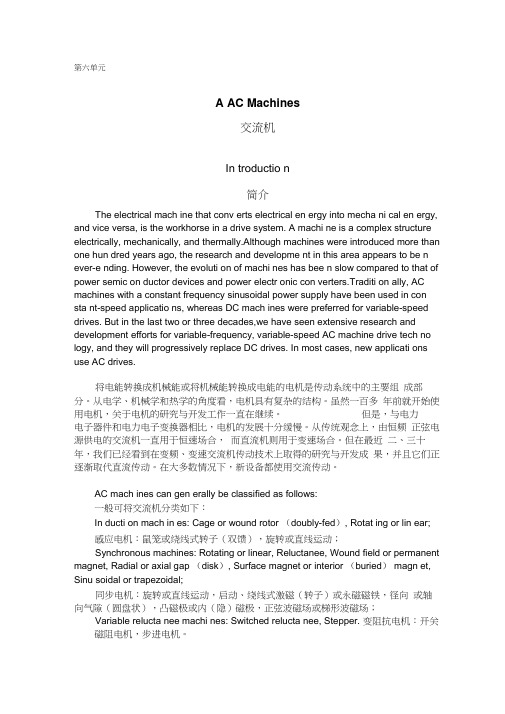
第六单元A AC Machines交流机In troductio n简介The electrical mach ine that conv erts electrical en ergy into mecha ni cal en ergy, and vice versa, is the workhorse in a drive system. A machi ne is a complex structure electrically, mechanically, and thermally.Although machines were introduced more than one hun dred years ago, the research and developme nt in this area appears to be n ever-e nding. However, the evoluti on of machi nes has bee n slow compared to that of power semic on ductor devices and power electr onic con verters.Traditi on ally, AC machines with a constant frequency sinusoidal power supply have been used in con sta nt-speed applicatio ns, whereas DC mach ines were preferred for variable-speed drives. But in the last two or three decades,we have seen extensive research and development efforts for variable-frequency, variable-speed AC machine drive tech no logy, and they will progressively replace DC drives. In most cases, new applicati ons use AC drives.将电能转换成机械能或将机械能转换成电能的电机是传动系统中的主要组成部分。
自动化专业英语原文和翻译
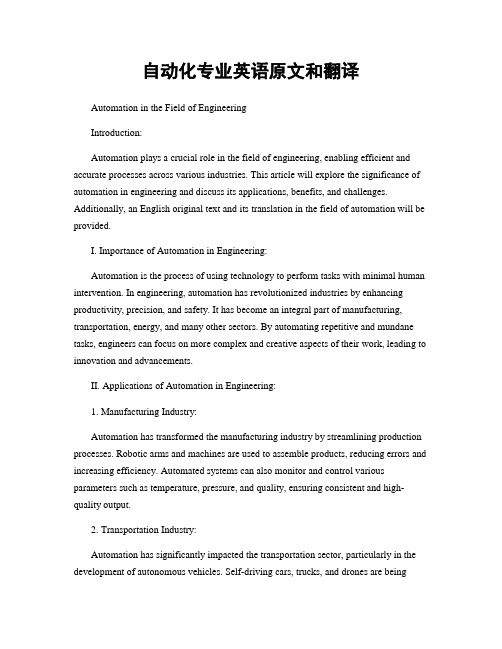
自动化专业英语原文和翻译Automation in the Field of EngineeringIntroduction:Automation plays a crucial role in the field of engineering, enabling efficient and accurate processes across various industries. This article will explore the significance of automation in engineering and discuss its applications, benefits, and challenges. Additionally, an English original text and its translation in the field of automation will be provided.I. Importance of Automation in Engineering:Automation is the process of using technology to perform tasks with minimal human intervention. In engineering, automation has revolutionized industries by enhancing productivity, precision, and safety. It has become an integral part of manufacturing, transportation, energy, and many other sectors. By automating repetitive and mundane tasks, engineers can focus on more complex and creative aspects of their work, leading to innovation and advancements.II. Applications of Automation in Engineering:1. Manufacturing Industry:Automation has transformed the manufacturing industry by streamlining production processes. Robotic arms and machines are used to assemble products, reducing errors and increasing efficiency. Automated systems can also monitor and control various parameters such as temperature, pressure, and quality, ensuring consistent and high-quality output.2. Transportation Industry:Automation has significantly impacted the transportation sector, particularly in the development of autonomous vehicles. Self-driving cars, trucks, and drones are beingtested and implemented, offering safer and more efficient transportation options. Automation in logistics and supply chain management has also improved delivery accuracy and speed.3. Energy Sector:Automation has revolutionized the energy sector by optimizing power generation, distribution, and consumption. Smart grids and automated control systems allow for efficient monitoring and management of energy resources. This leads to reduced energy wastage, cost savings, and a more sustainable approach to energy production.4. Construction Industry:Automation in the construction industry has improved safety, precision, and productivity. Robotic systems can be used for tasks such as bricklaying, welding, and concrete pouring. Drones equipped with cameras and sensors enable site inspections, progress monitoring, and surveying, reducing human effort and time.III. Benefits of Automation in Engineering:1. Increased Productivity:Automation speeds up processes, reduces errors, and increases output, leading to higher productivity. With automation, engineers can accomplish tasks in a shorter time frame, allowing for more projects to be completed.2. Improved Accuracy:Automated systems perform tasks with precision and consistency, minimizing human errors. This is particularly important in industries where precision is crucial, such as aerospace and medical device manufacturing.3. Enhanced Safety:Automation eliminates the need for humans to perform hazardous or repetitive tasks, reducing the risk of accidents and injuries. Robots and automated systems can handle dangerous materials, work in extreme conditions, and operate in confined spaces.4. Cost Savings:Although the initial investment in automation can be significant, it often results in long-term cost savings. Automated systems reduce labor costs, minimize material wastage, and optimize energy consumption, leading to improved profitability.IV. Challenges in Implementing Automation:1. Cost and Complexity:Implementing automation can be costly, especially for small and medium-sized enterprises. The integration of automated systems may require significant investments in technology, infrastructure, and employee training.2. Workforce Adaptability:Automation may lead to job displacement or require upskilling of the existing workforce. It is crucial to provide training and support to employees to ensure a smooth transition and maximize the benefits of automation.3. Cybersecurity Risks:Automation relies heavily on interconnected systems and data exchange, making them vulnerable to cyber threats. Robust cybersecurity measures must be implemented to protect automated systems from unauthorized access and potential disruptions.V. English Original Text and Translation - Automation in Engineering:English Original Text:Automation has revolutionized the field of engineering, enabling efficient and accurate processes across various industries. By automating repetitive tasks, engineers can focus on more complex aspects of their work, leading to innovation and advancements. Automation has found applications in manufacturing, transportation, energy, and construction industries, among others. It has increased productivity, improved accuracy, enhanced safety, and resulted in cost savings. However, implementing automation can be challenging due to its cost, complexity, and the need forworkforce adaptability. Robust cybersecurity measures are also essential to protect automated systems.Translation:自动化已经在工程领域引起了革命性的变化,为各个行业实现了高效准确的工艺流程。
自动化专业英语原文和翻译

自动化专业英语原文和翻译英文原文:Automation in the field of engineering has brought about significant advancements and revolutionized various industries. With the help of cutting-edge technology and innovative solutions, automation has become an integral part of many processes, increasing efficiency and productivity.In the field of automation engineering, professionals are responsible for designing, developing, and implementing automated systems and machinery. These systems are designed to perform tasks with minimal human intervention, reducing the risk of errors and improving overall performance.Automation engineering involves the use of various tools and technologies such as programmable logic controllers (PLCs), robotics, and computer-aided design (CAD) software. These tools enable engineers to design and control complex systems, ensuring smooth operations and optimal performance.One of the key benefits of automation in engineering is the ability to streamline processes and reduce manual labor. By automating repetitive tasks, engineers can focus on more complex and critical aspects of their work, leading to increased productivity and higher quality output.Moreover, automation plays a crucial role in enhancing safety in various industries. By replacing human workers with automated systems, the risk of accidents and injuries can be significantly reduced. Automated systems are designed to follow strict safety protocols and can perform tasks in hazardous environments that may be dangerous for humans.In addition to improving efficiency and safety, automation also offers cost-saving benefits. Although the initial investment in automation technology may be high, the long-term savings in labor costs and increased productivity outweigh the initial expenses.Automation can also lead to reduced material wastage and improved resource management.Automation engineering professionals play a vital role in the design and implementation of automated systems. They are responsible for conducting thorough analysis, developing system requirements, and ensuring seamless integration of automation technology into existing processes. They also provide technical support and troubleshooting expertise to address any issues that may arise.In conclusion, automation in the field of engineering has revolutionized various industries by increasing efficiency, productivity, and safety. Automation engineering professionals play a crucial role in designing and implementing automated systems, utilizing cutting-edge technology and innovative solutions. With the continuous advancements in automation technology, the future of engineering looks promising, with even greater possibilities for improved performance and streamlined processes.中文翻译:自动化在工程领域带来了重大的进步,并对各行各业进行了革命性的改变。
自动化专业英语原文和翻译
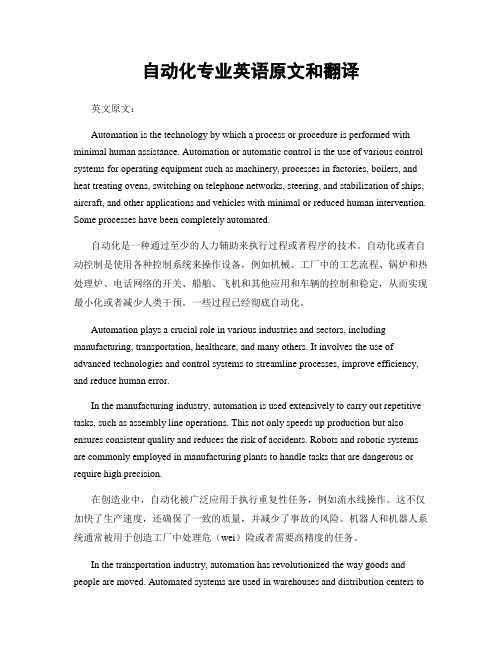
自动化专业英语原文和翻译英文原文:Automation is the technology by which a process or procedure is performed with minimal human assistance. Automation or automatic control is the use of various control systems for operating equipment such as machinery, processes in factories, boilers, and heat treating ovens, switching on telephone networks, steering, and stabilization of ships, aircraft, and other applications and vehicles with minimal or reduced human intervention. Some processes have been completely automated.自动化是一种通过至少的人力辅助来执行过程或者程序的技术。
自动化或者自动控制是使用各种控制系统来操作设备,例如机械、工厂中的工艺流程、锅炉和热处理炉、电话网络的开关、船舶、飞机和其他应用和车辆的控制和稳定,从而实现最小化或者减少人类干预。
一些过程已经彻底自动化。
Automation plays a crucial role in various industries and sectors, including manufacturing, transportation, healthcare, and many others. It involves the use of advanced technologies and control systems to streamline processes, improve efficiency, and reduce human error.In the manufacturing industry, automation is used extensively to carry out repetitive tasks, such as assembly line operations. This not only speeds up production but also ensures consistent quality and reduces the risk of accidents. Robots and robotic systems are commonly employed in manufacturing plants to handle tasks that are dangerous or require high precision.在创造业中,自动化被广泛应用于执行重复性任务,例如流水线操作。
自动化专业英语原文和翻译

自动化专业英语原文和翻译Automated Professional English Original Text and TranslationOriginal Text:Automation plays a crucial role in the field of engineering, particularly in the domain of industrial processes. It involves the use of control systems and information technologies to reduce human intervention, increase efficiency, and improve productivity.In the context of the automation industry, professionals need to have a strong command of English to effectively communicate and collaborate with international partners and clients. Therefore, it is essential for students studying automation to develop their English language skills, especially in technical and professional contexts.The curriculum for automation majors should include courses that focus on English for specific purposes, such as technical writing, presentations, and negotiations. These courses should provide students with the necessary vocabulary, grammar, and communication strategies to effectively convey complex technical information in English.In addition to language skills, automation professionals should also be familiar with industry-specific terminology and concepts. They should have a solid understanding of automation systems, robotics, control systems, and programming languages commonly used in the field. This knowledge will enable them to effectively communicate and work with colleagues and clients from different countries.Furthermore, automation professionals should be aware of the latest advancements and trends in the industry. They should stay updated on new technologies, regulations, and best practices. This can be achieved through continuous professional development, attending conferences, workshops, and participating in online forums and communities.Translation:自动化在工程领域中起着至关重要的作用,特别是在工业过程领域。
- 1、下载文档前请自行甄别文档内容的完整性,平台不提供额外的编辑、内容补充、找答案等附加服务。
- 2、"仅部分预览"的文档,不可在线预览部分如存在完整性等问题,可反馈申请退款(可完整预览的文档不适用该条件!)。
- 3、如文档侵犯您的权益,请联系客服反馈,我们会尽快为您处理(人工客服工作时间:9:00-18:30)。
Using the equations for the voltage drops in a resistor and inductor, we have
di L Ri e dt
Eq.(1-1A-6) is the differential equation for the current in the circuit.
occur
存在,
independent of
不依赖,独立于 ,
draw from
从(某处)取出,从。。。得到
The aforementioned battery and generator are regarded as voltage sources since their voltage is essentially constant with load.
conventional current 电流方向
Active electrical devices involve the conversion of energy to electrical form. For example, the electrical energy in a battery is derived from its stored chemical energy.
In studying the behavior of an electrical network, we are interested in determining the voltages and currents that exist within the circuit.
Since a network is composed of passive circuit elements, we must first define the electrical characteristics of these elements.
di uL dtቤተ መጻሕፍቲ ባይዱ
The voltage developed across a capacitor is proportional to the electric charge q accumulating on the plates of the capacitor.
Since the accumulation of charge may be expressed as the summation, or integral, of the charge increments dq, we have the equation 1
Symbolic representations of voltage and current sources are shown in Fig.1-1A-2.
A common method of analyzing an electrical network is mesh or loop analysis.
WORDS AND TERMS voltage drop 电压降 in series 串联 differential adj. 微分的; n. 微分 variable n. 变量 outline n. 轮廓; v. 提出 的要点 eliminate v. 消除,对消
TEXT
An electrical circuit or network is composed of elements such as resisters, inductors, and capacitors connected together in some manner.
Although current sources are not as familiar in practice, the concept does find wide use in representing an amplifying device, such as the transistor, by means of an equivalent electrical circuit.
WORDS AND TERMS characteristic adj. 特性(的);n. 特 性曲线 Ohm n. 欧姆 Faraday n. 法拉第 electric charge 电荷 integral n. 积分 increment n. 增量 armature n. 电枢,衔铁,加固
WORDS AND TERMS aforementioned adj. 上述的,前面提到的 represent v. 代表,表示 amplify v. 放大 symbolic adj. 符号的,记号的 mesh n. 网孔 Kirchhoff’s first law 基尔霍夫第一定律 loop current 回路电流
In the case of a resistor, the voltage-current relationship is given by Ohm’s law, which states that the voltage across the resistor is equal to the current through the resistor multiplied by the value of the resistance.
Thus an increment of charge dq is equal to the current multiplied by the corresponding time increment, or dq=idt. Eq.(1-1A-3) may then be written as
1 u idt C
e uR uL 0
The input voltage is summed negatively since, in the direction of assumed current, it represents an increase in voltage.
The drop across each passive element is positive since the current is in the direction of the developed voltage.
Consider the circuit shown in Fig. 1-1A-3a, which consists of an inductor and resistor connected in series to a voltage source e.
Assuming a loop current i, the voltage drops summed around the loop are
PART 1
Electrical and Electronic Engineering Basics
UNIT 1
A
Electric Networks
WORDS AND TERMS
network n. 网络,电路 resistor n. 电阻器 inductor n. 电感器 capacitor n. 电容器 passive network 无源网络 active network 有源网络
be derived from 源自于
The electrical energy of a generator is a result of the mechanical energy of rotating armature.
Active electrical elements occur in two basic forms: voltage sources and current sources. In their ideal form, voltage sources generate a constant voltage independent of the current drawn from the source.
It may be that the inductor voltage rather than the current is the variable of interest in the circuit.
If the network contains no energy sources, such as batteries or electrical generators, it is known as a passive network.
On the other hand, if one or more energy sources are present, the resultant combination is an active network.
Mathematically, this is expressed as
u iR
The voltage across a pure inductor is defined by Faraday’s law, which states that the voltage across the inductor is proportional to the rate of change with time of the current through the inductor. Thus we have
On the other hand, current source produce a current whose magnitude is independent of the load connected to the source.
be independent of 无关 Magnitude 量值
A summary of Eq.(1-1A-1), (11A-2) and (1-1A-4) for the three forms of passive circuit elements is given in fig. 1-1A-1.
